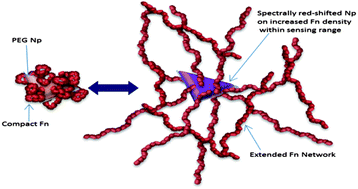Detection of fibronectin conformational changes in the extracellular matrix of live cells using plasmonic nanoplates†
Abstract
Protein conformational changes are detected both in vitro and for the first time in the presence of living cells using versatile plasmonic nanoplates. Au-edge-coated triangular silver nanoplates (AuTSNP) exhibit some of the highest refractive index sensitivity values recorded to date and exhibit a strong spectral response to surface biomolecular interactions. Large spectral shifts of over 30 nm distinguish between pH induced compact and extended conformations of the ubiquitous extracellular matrix protein fibronectin (Fn). Conformational transition of Fn from compact to extended is accompanied by a red spectral shift of 27 nm while a corresponding blue spectral shift of 25 nm accompanies the reverse conformational transition. Cleavage of Fn by cathepsin B, which plays an important role in cellular functions and in cancer metastasis is characterised by a blue spectral shift with detection in serum using a straightforward no-wash assay demonstrated. Spectral monitoring of nanoplates decorated with Fn and incubated with MDCK II cells shows extensive shifts of 156 nm and cellular morphological re-arrangement as Fn uncoils from a compact format to from fibrils within the extracellular matrix.


 Please wait while we load your content...
Please wait while we load your content...